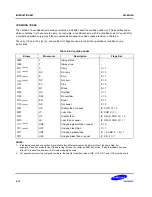
S3C80A5B
INTERRUPT STRUCTURE
5-15
INTERRUPT PENDING FUNCTION TYPES
Overview
There are two types of interrupt pending bits: One type is automatically cleared by hardware after the interrupt
service routine is acknowledged and executed; the other type must be cleared by the interrupt service routine.
Pending Bits Cleared Automatically by Hardware
For interrupt pending bits that are cleared automatically by hardware, interrupt logic sets the corresponding
pending bit to "1" when a request occurs. It then issues an IRQ pulse to inform the CPU that an interrupt is waiting
to be serviced. The CPU acknowledges the interrupt source by sending an IACK, executes the service routine,
and clears the pending bit to "0". This type of pending bit is not mapped and cannot, therefore, be read or written
by application software.
In the S3C80A5B interrupt structure, the timer 0 and timer 1 overflow interrupts (IRQ0 and IRQ1), and the counter
A interrupt (IRQ4) belong to this category of interrupts whose pending condition is cleared automatically by
hardware.
Pending Bits Cleared by the Service Routine
The second type of pending bit must be cleared by program software. The service routine must clear the
appropriate pending bit before a return-from-interrupt subroutine (IRET) occurs. To do this, a "0" must be written
to the corresponding pending bit location in the source's mode or control register.
In the S3C80A5B interrupt structure, pending conditions for all interrupt sources
except
the timer 0 and timer 1
overflow interrupts and the counter A borrow interrupt, must be cleared by the interrupt service routine.
















































